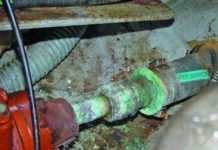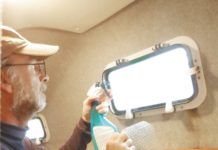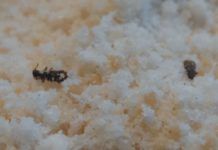Like most boats I’ve been in, that unpleasant foul smell emanating from onboard sanitation systems is not uncommon. Some smell worse than others!
For those that pump out and rinse their holding tanks very regularly or that flush overboard (such as boats navigating offshore), the smell can be reduced by a lot. To the point where it can be somewhat endurable.
But if managing and controlling these unpleasant odors is as important to you as it is to me (and my guests), then understanding where and what are the causes becomes important and helpful.
KEEP LAKE WATER OUT
Although there are many possibilities, which I will enumerate later, for freshwater boats, one important and often neglected or unknown cause, is the lake water itself, which is pumped in to flush the toilet and remains in the holding tank until pumped out.
Fresh water contains billons of microorganisms that help keep and maintain our freshwater lakes and rivers clean and full of life. But once pumped into the holding tank, along with human waste product and various sanitary products that are often added, these microorganisms start to die and decay and are generally the biggest cause of the bad smell. Add prolonged hot sunny days and extended times when the boat is closed off for the week and the process occurs at a much faster pace.

Add a freshwater tank. This is why, some boat owners opt to add an extra dedicated freshwater tank to be used for the toilet. Because these freshwater tanks are filled in port, using treated tap water, the naturally occurring microorganisms are not present and therefore no longer a factor, hence reducing considerably the unpleasant smell.
Adding a dedicated freshwater tank is not a difficult or expensive task and the results are well worth the effort. There are many freshwater tanks available on the market, such as rigid or soft bladder styles available in many sizes and shapes, some also come with all the accessories you will need, such as hoses, clamps, etc.
Based on your holding tank capacity, the room available under the forward V-berth and the access opening, select the type, capacity and size of tank that will work best for you. Soft bladder tanks come with ready made attachment points to prevent the blader from moving around while under way or heeling under sail. For hard or ridged tanks, you will have to create or make a proper bed that can be used to strap and secure the tank in place.
 I personally prefer the soft bladder tanks as they can be folded and easily pass through any opening under the V-berth. They can be secured easily and removed anytime. The rest of the installation is basically the same for either style of tank.
I personally prefer the soft bladder tanks as they can be folded and easily pass through any opening under the V-berth. They can be secured easily and removed anytime. The rest of the installation is basically the same for either style of tank.
You will need extra hose to reach the toilet water seacock inlet area, where a three-way valve will be needed to select where the water will come from. This way, if you happen to run out of fresh water, you can always switch back to lake water.


By the way, if you happen to be in salt water and flush overboard, adding a dedicated freshwater tank for your toilet(s) will also help control odors and greatly reduce toilet component and discharge hose decay as you would be flushing out fresh water. Thus, reducing the frequency of servicing the toilet components by quite a bit.
Just after the three-way valve, I recommend installing a serviceable water filter, such as the Jabsco Pumpgard 46400-002 which comes with a serviceable stainless-steel filter and a see-through cover for quick and easy inspections.
This was such a simple add-on, I only wish I had thought of it years ago!

ADD IN FABRIC SOFTENER TO THE SYSTEM
Also, it’s becoming more and more popular to add fabric softener to the sanitation system once in a while via the toilet. Many have tried different brands, but for some reason, the Fleecy brand outperforms other brands. It keeps a very pleasant smell for a long time!
HOLDING TANK MAINTENANCE CALENDAR
Effective holding tank treatment: A good maintenance process starts in the fall before haul out, when the tank should be emptied and flushed with fresh water at least two or three times. Rinsing the sanitation hose from the toilet to the holding tank is also a good practice, so remember to If winterizing, I also flush about two quarts of holding tank-safe antifreeze. Don’t forget to keep the seacock open for the winter.
In the spring, after launch, I flush one or two liters of white vinegar in the toilet then add about five gallons of fresh water in the holding tank via the waste outlet on deck. I then go sailing or motoring in order to move and swoosh the liquid around in the tank and hoses. Once back in harbor, I let this mixture sit in the tank for a day or two, then do a pump-out.
By the way, if you’re in salt water, even though you may be flushing overboard, white vinegar flushes are a great way to keep your toilet, hoses (and tank) clear of salt build up, which keeps toilets from clogging. Keep white vinegar on hand and flush some on a regular basis.
Part sources:
Barker Manufacturing Company 11917 26Gal. Water Tank Kit, Waste Water & Sanitation – Amazon Canada
Elkhart 28910 3-Way by-Pass Crimp Valve, Black, Faucets – Amazon Canada
Jabsco Pumpgard in-Line Strainer 3/4″ Barb (Low Profile), Plumbing Fittings – Amazon Canada
Brands of odor resistant sanitation hose brands include:
- Raritan Sani-Flex Odor Shield hose
- Odor Safe Plus Sanitation Hose by Dometic
- Trident Marine Sani Shield Sanitation Hose









































An alternative is to plumb the drain of the sink in the head to the flush inlet of the bowl. There is never a connection between freshwater system and the head. Go easy on the anti microbial soap and feed your holding tank with CP or Orderlos.
Hello Gerald. Thanks for being a reader and for your comment. How exactly would you “plumb the head sink drain to the toilet flush inlet”. I understand the visual, I think. But not sure I see how the sink will drain normally afterwards. Also, if I understand your suggestion, would this not use up the main fresh water tank? My intention was the not use up the main fresh water tank. Use the extra tank for the toilet only. If you have any pictures or drawings, you can send them to me at [email protected]. Thanks again.